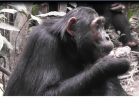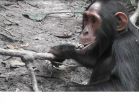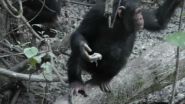INFORMATION:
Coauthor Dr Cat Hobaiter, from St Andrews University, commented: 'Chimpanzees are often thought of as being very conservative, and the destruction of their natural feeding species can be hugely problematic. It's fascinating to see that Budongo chimps may compensate for the loss of one major source of minerals in their diet by increasing their use of alternatives like the clay.'
The researchers compared clay with ground soil, which, at Budongo, chimps do not eat. This is in contrast with chimpanzees living in Kibale Forest, where ground soil is regularly eaten.
For more information, contact the University of Oxford News Office on +44 (0)1865 280534 or news.office@admin.ox.ac.uk
NOTE TO EDITORS:
*The paper 'Mineral acquisition from clay by Budongo Forest chimpanzees' by Vernon Reynolds et al will be published by PLOS ONE. It is strictly embargoed until 2pm ET (7pm BST)
*Images and video are available from the University of Oxford News office on request. Please credit: Brittan Fallon.
Chimpanzees binge on clay to detox and boost the minerals in their diet
The chimps in Ugandan Budongo forest have recently started to boost the minerals in their diet by eating the clay which also helps them 'detox' and digest their food
2015-07-28
(Press-News.org) Wild chimpanzees in the forests of Uganda are increasingly eating clay to supplement the minerals in their diet, according to a long-term international study published in the early version of the journal PLOS ONE. The paper led by the University of Oxford describes how the researchers observed wild chimpanzees in the Budongo forest eating and drinking from clay pits and termite mounds. The paper concludes that this change in diet may be partly due to the widespread destruction of raffia palm trees that chimps relied on for their minerals in the past. However, the main reason seems to be the chimps have recently started to boost the minerals in their diet by eating the clay which also helps them 'detox' and digest their food.
The research was led by Emeritus Professor of Biological Anthropology at Oxford University, Vernon Reynolds, with a team of researchers from the universities of St Andrews, Brighton, Kent, Neuchatel, and Utrecht. Researchers observed the chimps using leaves like clay 'sponges', dipping the leaves in the clay water and returning to their mouths where they squeezed the liquid out with their tongues. They were also seen using their fingers to extract lumps of clay directly from the ground before eating it.
Studies of wild chimpanzees in the Budongo Forest, Western Uganda, have been continuing uninterrupted since 1990, when Professor Reynolds set up the Budongo Conservation Field Station there.
An analysis of the clay and termite soils shows they are very high in a range of minerals, but the clay was particularly high in aluminium - a feature of kaolinite clays eaten by a range of species, including humans, to aid digestion and detoxification. The chimps' diet, which consists mainly of fruits and leaves, is very high in tannins and the researchers believe that the clay provides an important way for chimpanzees to neutralize these. It is common practice for local women in Budongo to drink or eat forest clay mixed with water for stomach problems and during pregnancy. Clays, such as kaolinite, also contain sodium, calcium, iron, magnesium and potassium, says the paper, which the Budongo chimps seem to have discovered they can access with their leaf sponges. Accessing the clay with the leaf sponges was also found to provide higher mineral concentrations than taking clay-water or clay directly from the ground.
Before 2000 feeding on raffia palms was commonly observed among the Sonso chimps, but after 2005 it started to decline. Meanwhile, after 2005, clay soil feeding in Budongo seems to have increased, possibly because of the scarcity of raffia-palm trees which are now used in the local tobacco industry with the leaf stems being used for tying and curing tobacco leaves. The decaying pith of these palm trees was previously an important source of minerals for the chimpanzees.
Lead author Professor Reynolds, from Oxford University, said: 'Raffia is a key source of sodium, but to our surprise the sodium content was very low in the diet so this does not appear to be the main reason for the new clay-bingeing. Instead the wide range of minerals present in their diet suggests that clay is eaten as a general mineral supplement.'
ELSE PRESS RELEASES FROM THIS DATE:
Autism costs estimated to reach nearly $500 billion, potentially $1 trillion, by 2025
2015-07-28
(SACRAMENTO, Calif.) -- UC Davis health economists have for the first time projected the total costs of caring for all people with autism spectrum disorder (ASD) in the U.S. for the current calendar year and in 10 years if effective interventions and preventive treatments for the condition are not identified and widely available.
Their forecasts for ASD-related medical, nonmedical and productivity losses are $268 billion for 2015 and $461 billion for 2025. The researchers noted that these estimates are conservative and, if ASD prevalence continues to increase as it has ...
Improvement in the quality of VMMC made possible through the continuous quality improvement approach
2015-07-28
The continuous quality improvement (CQI) approach was introduced on a pilot basis to 30 sites across Uganda. This approach identified barriers in achieving national standards for voluntary medical male circumcision (VMMC), identified possible solutions to overcome these barriers, and carried out improvement plans to test these changes while collecting performance data to objectively measure whether they had bridged gaps.
Teams used a 53-indicator quality assessment tool adapted by the Ministry of Health and based on the WHO VMMC Quality Toolkit as a management tool to ...
World's first bilateral hand transplant on child at Children's Hospital of Philadelphia
2015-07-28
Surgeons at The Children's Hospital of Philadelphia (CHOP) joined with colleagues from Penn Medicine recently to complete the world's first bilateral hand transplant on a child. Earlier this month, the surgical team successfully transplanted donor hands and forearms onto eight-year-old Zion Harvey who, several years earlier, had undergone amputation of his hands and feet and a kidney transplant following a serious infection.
Led by L. Scott Levin, M.D., FACS*, Chairman of the Department of Orthopaedic Surgery at Penn Medicine, Director of the Hand Transplantation Program ...
How to digitally stoke that old-time auction fever
2015-07-28
Whether online auctions are selling rare Pokemon cards or fine art, the science behind inciting the highest bids gets a boost from a paper to be published in the September issue of the Journal of Retailing. Researchers from Germany and Australia teamed up to explore how bidders' emotions are affected by different types of auctions and how those emotions affect their bidding.
In "Auction Fever! How Time Pressure and Social Competition Affect Bidders' Arousal and Bids in Retail Auctions," the three authors - Marc T.P. Adam of the University of Newcastle, Professor ...
Sleepy fruitflies get mellow
2015-07-28
PHILADELPHIA - Whether you're a human, a mouse, or even a fruitfly, losing sleep is a bad thing, leading to physiological effects and behavioral changes. One example that has been studied for many years is a link between sleep loss and aggression. But it can be difficult to distinguish sleep loss effects from stress responses, especially in rodent or human models.
A team of researchers from the Perelman School of Medicine at the University of Pennsylvania used fruitflies to probe deeper into the cellular and molecular mechanisms that govern aggression and sleep. They ...
Firms 'underinvest' in long-term cancer research
2015-07-28
Pharmaceutical firms "underinvest" in long-term research to develop new cancer-fighting drugs due to the greater time and cost required to conduct such research, according to a newly published study co-authored by MIT economists.
Specifically, drugs to treat late-stage cancers are less costly to develop than drugs for earlier-stage cancers, partly because the late-stage drugs extend people's lives for shorter durations of time. This means that the clinical trials for such drugs get wrapped up more quickly, too -- and provide drug manufacturers more time to control patented ...
Penn Vet study shows immune cells in the skin remember and defend against parasites
2015-07-28
Just as the brain forms memories of familiar faces, the immune system remembers pathogens it has encountered in the past. T cells with these memories circulate in the blood stream looking for sites of new infection.
Recently, however, researchers have shown that memory T cells specific to viral infections can also set up residence in particular tissues. There, they stand guard, ready to respond quickly to the first sign of reinfection.
Now, research led by a team from the University of Pennsylvania School of Veterinary Medicine shows that these resident memory T cells ...
New eye-tracker method shows 'preferred retinal location' in both eyes
2015-07-28
July 28, 2015 - Eyes with central vision loss adapt by developing a new fixation point in a different part of the retina, called the preferred retinal location (PRL). Now for the first time, a new method makes it possible to identify PRLs in both eyes simultaneously, reports a study in the August issue of Optometry and Vision Science, official journal of the American Academy of Optometry. The journal is published by Wolters Kluwer.
The new eye-tracker technique may help in developing visual rehabilitation approaches to improve binocular vision for the many older adults ...
Cellphones can steal data from 'air-gapped computers' according to Ben Gurion University researchers
2015-07-28
BEER-SHEVA, Israel...July 28, 2015 - Researchers at the Ben-Gurion University of the Negev (BGU) Cyber Security Research Center have discovered that virtually any cellphone infected with a malicious code can use GSM phone frequencies to steal critical information from infected "air-gapped" computers.
Air-gapped computers are isolated -- separated both logically and physically from public networks -- ostensibly so that they cannot be hacked over the Internet or within company networks.
Led by BGU Ph.D. student Mordechai Guri, the research team discovered how to turn ...
Doctor Google: How age and other factors influence online health information searches
2015-07-28
Consumers have access to multiple Web sites to search for online health information and can be far more involved in managing their own medical issues than ever before. However, this wealth of resources can make finding accurate information difficult, especially because it is often spread across multiple sites. A new study published in the Journal of Cognitive Engineering and Decision Making aims to evaluate the types of search strategies that Internet users adopt when trying to solve a complicated health problem.
Joseph Sharit, a professor in the Department of Industrial ...
LAST 30 PRESS RELEASES:
Managing meandering waterways in a changing world
Expert sounds alarm as mosquito-borne diseases becoming a global phenomenon in a warmer more populated world
Climate change is multiplying the threat caused by antimicrobial resistance
UK/German study - COVID-19 vaccine effectiveness and fewer common side-effects most important factors in whether adults choose to get vaccinated
New ultraviolet light air disinfection technology could help protect against healthcare infections and even the next pandemic
Major genetic meta-analysis reveals how antibiotic resistance in babies varies according to mode of birth, prematurity, and where they live
Q&A: How TikTok’s ‘black box’ algorithm and design shape user behavior
American Academy of Arts and Sciences elects three NYU faculty as 2024 fellows
A closed-loop drug-delivery system could improve chemotherapy
MIT scientists tune the entanglement structure in an array of qubits
Geologists discover rocks with the oldest evidence yet of Earth’s magnetic field
It’s easier now to treat opioid addiction with medication -- but use has changed little
Researchers publish final results of key clinical trial for gene therapy for sickle cell disease
Identifying proteins causally related to COVID-19, healthspan and lifespan
New study reveals how AI can enhance flexibility, efficiency for customer service centers
UT School of Natural Resources team receives grant to remove ‘forever chemicals’ from water
Sweet potato quality analysis is enhanced with hyperspectral imaging and AI
Use of acid reflux drugs linked to higher risk of migraine
For immigrants to Canada, risk of MS increases with proportion of life spent there
Targeted use of enfortumab vedotin for the treatment of advanced urothelial carcinoma
A university lecture, with a dash of jumping jacks
How light can vaporize water without the need for heat
These giant, prehistoric salmon had tusk-like teeth
New study infers our wellbeing by analyzing the language we use around ageing, using language markers to enable "a different type of access to individuals’ inner worlds"
New research confirms plastic production is directly linked to plastic pollution
MSU researchers uncover 'parallel universe' in tomato genetics
Grey cuckoo, red cuckoo: unveiling the genomic secrets of color polymorphism in female cuckoo birds
CHOP researchers discover underlying biology behind Fontan-associated liver disease
A flexible microdisplay can monitor brain activity in real-time during brain surgery
Diversity and productivity go branch-in-branch
[Press-News.org] Chimpanzees binge on clay to detox and boost the minerals in their dietThe chimps in Ugandan Budongo forest have recently started to boost the minerals in their diet by eating the clay which also helps them 'detox' and digest their food


